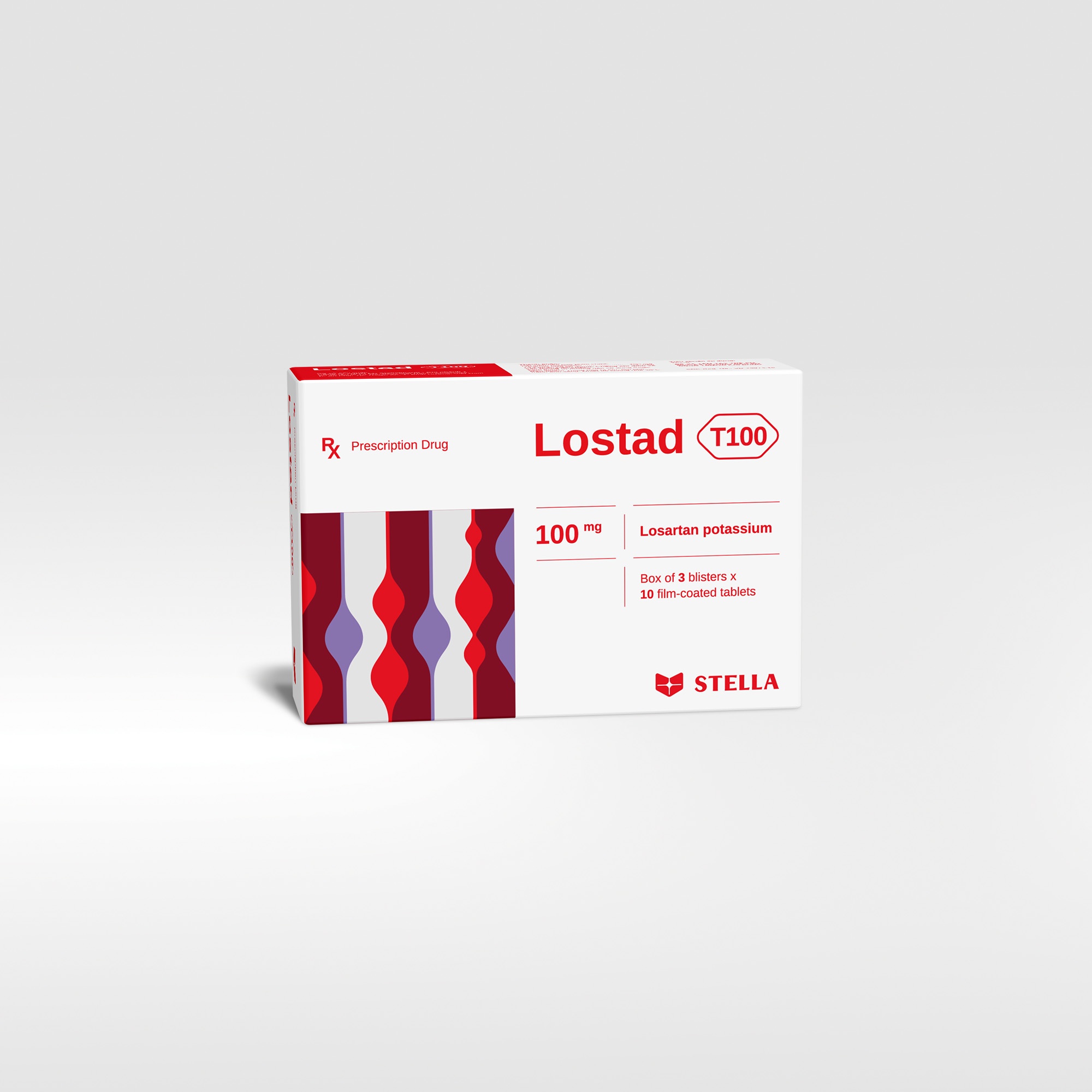Indications
- Hypertension.
- Reduction in the risk of cardiovascular morbidity and mortality in hypertensive adult patients with left ventricular hypertrophy.
Lostad T100 is indicated to reduce the risk of cardiovascular morbidity and mortality as measured by the combined incidence of cardiovascular death, stroke, and myocardial infarction in hypertensive patients with left ventricular hypertrophy.
- Renal protection in adult patients with hypertension and type 2 diabetes mellitus with proteinuria ≥ 0.5 g/day.
Lostad T100 reduces the rate of progression of nephropathy as measured by the occurrence of doubling of serum creatinine or end stage renal disease (need for dialysis or renal transplantation), or death; and decreased proteinuria.
- Heart failure
Treatment of chronic heart failure in adult patients when treatment with angiotensin-converting enzyme (ACE) inhibitors is not considered suitable due to incompatibility, especially cough, or contraindication. Patients with heart failure who have been stabilised with an ACE inhibitor should not be switched to losartan. The patients should have a left ventricular ejection fraction ≤ 40% and should be clinically stable and on an established treatment regimen for chronic heart failure.
Dosage
Hypertension
- The usual starting and maintenance dose is 50 mg once daily for most patients.
- The maximal antihypertensive effect is attained 3 – 6 weeks after initiation of therapy.
- Some patients may receive an additional benefit by increasing the dose to 100 mg once daily (in the morning).
- Losartan may be administered with other antihypertensive agents, especially with diuretics (e.g. hydrochlorothiazide).
Reduction in the risk of cardiovascular morbidity and mortality in hypertensive adult patients with left ventricular hypertrophy.
- The usual starting dose is 50 mg of losartan once daily.
- A low dose of hydrochlorothiazide should be added and/or the dose of losartan should be increased to 100 mg once daily based on blood pressure response.
Renal protection in adult patients with hypertension and type 2 diabetes mellitus with proteinuria ≥ 0.5 g/day.
- The usual starting dose is 50 mg once daily.
- The dose may be increased to 100 mg once daily based on blood pressure response.
- Losartan may be administered with other antihypertensive agents (e.g. diuretics, calcium channel blockers, alpha- or beta-blockers, and centrally acting agents) as well as with insulin and other commonly used hypoglycaemic agents (e.g. sulfonylureas, glitazones and glucosidase inhibitors).
Chronic heart failure
- The usual initial dose of losartan in patients with heart failure is 12.5 mg once daily.
- The dose should generally be titrated at weekly intervals (i.e. 12.5 mg daily, 25 mg daily, 50 mg daily, 100 mg daily, up to a maximum dose of 150 mg once daily) as tolerated by the patient.
Special populations
- Use in patients with intravascular volume depletion (e.g. those treated with high-dose diuretics): Starting dose of 25 mg once daily.
- Use in patients with renal impairment and haemodialysis patients: No initial dosage adjustment is necessary in patients with renal impairment and in haemodialysis patients.
- Use in patients with hepatic impairment: A lower dose should be considered for patients with a history of hepatic impairment. There is no therapeutic experience in patients with severe hepatic impairment. Therefore, losartan is contraindicated in patients with severe hepatic impairment.
Paediatric population
- 6 months – less than 6 years: The safety and efficacy of children aged 6 months to less than 6 years has not been established.
- 6 years to 18 years:
For patients who can swallow tablets, the recommended dose is 25 mg once daily in patients > 20 to < 50 kg (in exceptional cases the dose can be increased to a maximum of 50 mg once daily). Dosage should be adjusted according to blood pressure response.
In patients > 50 kg: Usual dose is 50 mg once daily.
In exceptional cases the dose can be adjusted to a maximum of 100 mg once daily.
Doses above 1.4 mg/kg (or in excess of 100 mg) daily have not been studied in paediatric patients.
Losartan is not recommended for use in children under 6 years old, as limited data are available in these patient groups.
Losartan is not recommended in children with glomerular filtration rate < 30 ml/min/1.73 m2, as no data are available.
Losartan is also not recommended in children with hepatic impairment.
Use in elderly
- Although consideration should be given to initiating therapy with 25 mg in patients over 75 years of age, dosage adjustment is not usually necessary for the elderly.
Usage
Lostad T100 should be swallowed whole with a glass of water. The tablets may be administered with or without food, on a full or empty stomach. Lostad T100 may be administered with other antihypertensive agents.
















